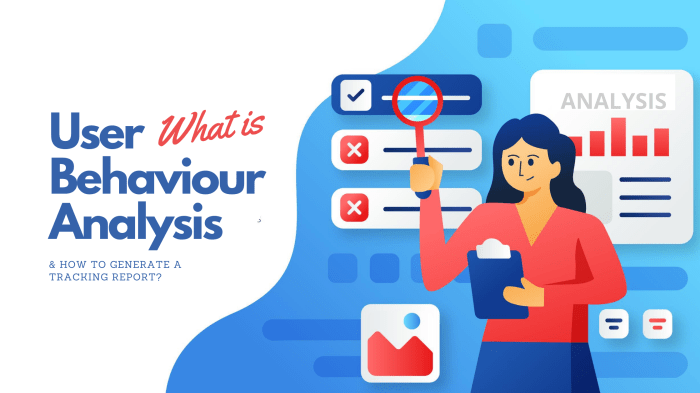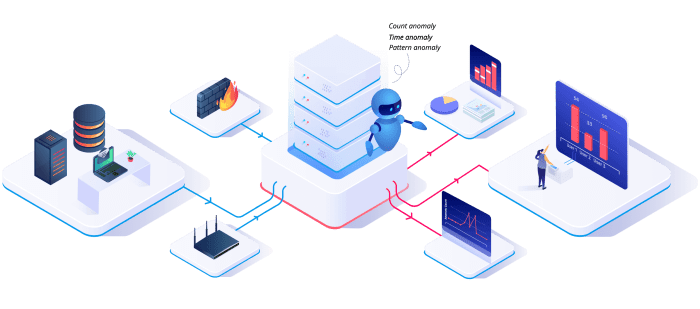User Behavior Analytics digs deep into understanding how users interact with systems, offering valuable insights for businesses across various industries. From predictive to prescriptive analytics, this powerful tool sheds light on user behavior in ways never seen before.
With real-world applications and cutting-edge technologies like AI and machine learning driving the analysis, User Behavior Analytics is revolutionizing the way organizations approach data-driven decision-making.
Overview of User Behavior Analytics
User Behavior Analytics (UBA) is a process of tracking, collecting, and analyzing user data to gain insights into how individuals interact with digital platforms. By examining patterns and behaviors, UBA helps organizations understand user preferences, predict future actions, and enhance overall user experience.
Importance of Analyzing User Behavior
User behavior analysis is crucial for businesses to make informed decisions and improve engagement with their target audience. By studying how users navigate websites, use apps, or interact with products, companies can optimize their offerings, tailor marketing strategies, and ultimately increase customer satisfaction and loyalty.
How User Behavior Analytics is Used in Various Industries
- E-commerce: UBA helps online retailers track user interactions, identify buying patterns, and personalize product recommendations to enhance sales conversion rates.
- Finance: Banks and financial institutions utilize UBA to detect fraudulent activities, monitor customer transactions, and improve security measures.
- Healthcare: UBA is used in healthcare to analyze patient behavior, predict medical outcomes, and enhance treatment plans for better patient care.
- Gaming: Gaming companies leverage UBA to understand player preferences, optimize game design, and create personalized gaming experiences to increase user engagement and retention.
Types of User Behavior Analytics

Predictive and prescriptive analytics are two key types of user behavior analytics. Predictive analytics involves forecasting future trends and outcomes based on historical data and statistical algorithms. On the other hand, prescriptive analytics goes a step further by not only predicting what will happen but also recommending actions to achieve a desired outcome.
Difference between Predictive and Prescriptive Analytics
Predictive analytics focuses on predicting future user behavior patterns, such as buying preferences or engagement levels, to help businesses make informed decisions. In contrast, prescriptive analytics not only predicts these behaviors but also provides actionable insights on how to optimize strategies to influence user behavior positively.
Descriptive Analytics in Understanding User Behavior
Descriptive analytics involves analyzing past user behavior data to understand trends, patterns, and anomalies. By examining historical data, businesses can gain insights into user preferences, interactions, and engagement levels to make informed decisions about marketing strategies, product offerings, and customer service improvements.
Real-World Applications
- Predictive Analytics: E-commerce platforms use predictive analytics to recommend products based on user browsing history and purchase behavior, increasing sales and customer satisfaction.
- Prescriptive Analytics: Healthcare providers utilize prescriptive analytics to optimize treatment plans for patients based on medical history, symptoms, and risk factors, improving patient outcomes and reducing costs.
- Descriptive Analytics: Social media platforms analyze user engagement metrics, such as likes, shares, and comments, to identify popular content trends and optimize the user experience through tailored recommendations and targeted advertising campaigns.
Tools and Technologies used in User Behavior Analytics

User Behavior Analytics relies on a variety of tools and technologies to gather, analyze, and interpret data related to user actions and interactions. These tools help organizations understand user behavior, identify patterns, and make informed decisions to improve user experience and security measures.
Popular Tools for User Behavior Analytics
- Google Analytics: A widely-used tool for tracking website traffic, user behavior, and conversions.
- Adobe Analytics: Provides advanced analytics capabilities to track user interactions across various digital channels.
- IBM Customer Experience Analytics: Offers insights into customer behavior and helps optimize digital experiences.
- Hotjar: Enables heat mapping, session recording, and feedback polls to understand user behavior on websites.
Comparison of Analytics Platforms
- Google Analytics: Offers a comprehensive set of features for tracking user behavior, audience segmentation, and conversion tracking.
- Adobe Analytics: Focuses on providing advanced analytics capabilities for large enterprises and customizable reporting.
- IBM Customer Experience Analytics: Emphasizes customer journey analysis and offers predictive analytics for personalized marketing strategies.
- Hotjar: Specializes in visual data such as heat maps and recordings to understand user interactions on websites.
Role of AI and Machine Learning in User Behavior Analysis, User Behavior Analytics
AI and machine learning play a crucial role in enhancing user behavior analysis by enabling automated insights, predictive analytics, and anomaly detection. These technologies help organizations identify trends, patterns, and anomalies in user behavior data at scale, leading to more accurate predictions and actionable insights for improving user experiences and security measures.
Challenges in Implementing User Behavior Analytics
Implementing User Behavior Analytics can be a complex process for organizations, presenting several challenges that need to be addressed. From data privacy concerns to technical issues, overcoming these obstacles is crucial for successful implementation.
Data Privacy Concerns
Maintaining data privacy is a significant challenge when implementing User Behavior Analytics. Organizations need to ensure that sensitive information is protected and that data is used responsibly. To overcome this challenge, companies should establish clear policies and procedures for handling user data, obtain consent from users before collecting data, and comply with relevant privacy regulations such as GDPR and CCPA.
Technical Complexity
The technical complexity of User Behavior Analytics tools and technologies can pose a challenge for organizations, especially those with limited resources or expertise. To address this challenge, companies can invest in training for their staff, leverage external expertise through consultants or service providers, and carefully evaluate and select user-friendly tools that align with their specific needs.
Lack of Integration
Another common challenge is the lack of integration between different data sources and systems within an organization. To overcome this challenge, companies should prioritize data integration efforts, establish a centralized data repository, and implement interoperable systems that can communicate with each other seamlessly.
Resistance to Change
Resistance to change from employees or stakeholders can hinder the successful implementation of User Behavior Analytics. To address this challenge, organizations should focus on change management strategies, communicate the benefits of User Behavior Analytics effectively, involve key stakeholders in the decision-making process, and provide training and support to ensure a smooth transition.
Security Vulnerabilities
Ensuring data security is essential in User Behavior Analytics to prevent unauthorized access or data breaches. Organizations should implement robust security measures such as encryption, access controls, and regular security audits to protect user data and maintain the integrity of their analytics processes.
Resource Constraints
Limited resources, whether in terms of budget, personnel, or technology, can also be a challenge in implementing User Behavior Analytics. To overcome this obstacle, organizations can prioritize their investments, seek cost-effective solutions, and consider partnerships or collaborations to leverage external resources and expertise.





